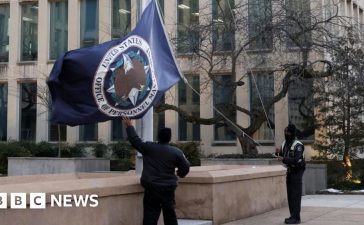There are just 20 supervolcanoes in the world, each an unusually large volcano that has the potential to produce an eruption that would affect the entire world.
Yellowstone supervolcano, or Yellowstone Caldera, is one of them. Situated in Wyoming’s Yellowstone National Park, it formed in the course of three supereruptions that occurred over the past 2.1 million years.
Volcanism at Yellowstone is in the grand scheme of things a relatively recent thing, with few other volcanoes of such size having experienced such large eruptions in such a short period.
Of all the volcanoes in the world, Yellowstone is the one that keeps volcanologists awake at night, for its eruption would send shockwaves across the world.
Experts are so fearful that NASA, the US space agency, previously launched an entire project focused on handling and containing any future eruption in a project like nothing before.
The plans drawn up by NASA scientists would not only spare the world from a deadly super eruption, they say, but also transform Yellowstone into a source of electric power.
Documents drawn up in 2017 were shared with the BBC, with Brian Wilcox of NASA’s Jet Propulsion Laboratory (JPL) at the California Institute of Technology, explaining: “I was a member of the NASA Advisory Council on Planetary Defense which studied ways for NASA to defend the planet from asteroids and comets.
“I came to the conclusion during that study that the supervolcano threat is substantially greater than the asteroid or comet threat.”
When the scientists looked at the volcano, the most logical solution they could come up with was to simply cool it down. A volcano the size of Yellowstone is essentially a giant heat generator, with enough power inside it to match six industrial power plants.
Some 60 to 70 percent of this heat is currently leaked from the volcano, however, seeping from within the surface’s cracks and emitting into the atmosphere.
The rest of the energy that remains beneath the Earth’s surface builds up inside the magma and dissolves volatile gases surrounding the rocks. It is in this that the beginning of eruptions occur. Once the heat reaches a certain threshold, an explosive event is inevitable.
If more of this heat could be extracted from the volcano, then it would in theory never erupt. This is when NASA comes in. The agency estimates that the caldera wouldn’t pose a threat if a 35 percent increase in heat transfer could be achieved from its magma chamber.
One way in which it might achieve this is to increase the amount of water inside the volcano. But convincing the powers that be to fund such a mammoth project would, the experts say, be almost impossible.
“Building a big aqueduct uphill into a mountainous region would be both costly and difficult, and people don’t want their water spent that way,” Mr Wilcox told the BBC. “People are desperate for water all over the world and so a major infrastructure project, where the only way the water is used is to cool down a supervolcano, would be very controversial.”
The most viable plan in their view would be to drill a hole some 10km into the supervolcano and pump the water down at high pressure. The returning circulating water would come out at a temperature of 350C and so, slowly but surely extract heat from the volcano.
While the project would cost a staggering £2.69billion, politicians may be more swayed by the potential financial incentives attached to it.
Mr Wilcox explained: “Yellowstone currently leaks around 6GW in heat. Through drilling in this way, it could be used to create a geothermal plant, which generates electric power at extremely competitive prices of around $0.10/kWh (£0.7/kWh).
“You would have to give the geothermal companies incentives to drill somewhat deeper and use hotter water than they usually would, but you would pay back your initial investment, and get electricity which can power the surrounding area for a period of potentially tens of thousands of years.
“And the long-term benefit is that you prevent a future supervolcano eruption which would devastate humanity.”
There are several risks associated with this method, not least triggering an eruption. Rather than drill into and through the top later of magma, scientists believe that coming in through the lower sides and at the boundaries of the national park would help to mitigate any serious adverse consequences.
The problem rests with the question of how long this solution might last. Decades? Hundreds of years? Thousands of years? It is impossible to say.
“With a project like this, you’d start the process and the main ongoing benefit you’d see in everyday terms is this new supply of electrical power,” Mr Wilcox noted.
The threat of a Yellowstone eruption will continue to be a cause of great concern for volcanologists and humanity alike. And though we may never find a solution, the quest for mitigation continues.












